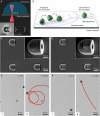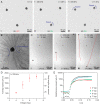Acoustically powered surface-slipping mobile microrobots
- PMID: 32015114
- PMCID: PMC7035478
- DOI: 10.1073/pnas.1920099117
Acoustically powered surface-slipping mobile microrobots
Abstract
Untethered synthetic microrobots have significant potential to revolutionize minimally invasive medical interventions in the future. However, their relatively slow speed and low controllability near surfaces typically are some of the barriers standing in the way of their medical applications. Here, we introduce acoustically powered microrobots with a fast, unidirectional surface-slipping locomotion on both flat and curved surfaces. The proposed three-dimensionally printed, bullet-shaped microrobot contains a spherical air bubble trapped inside its internal body cavity, where the bubble is resonated using acoustic waves. The net fluidic flow due to the bubble oscillation orients the microrobot's axisymmetric axis perpendicular to the wall and then propels it laterally at very high speeds (up to 90 body lengths per second with a body length of 25 µm) while inducing an attractive force toward the wall. To achieve unidirectional locomotion, a small fin is added to the microrobot's cylindrical body surface, which biases the propulsion direction. For motion direction control, the microrobots are coated anisotropically with a soft magnetic nanofilm layer, allowing steering under a uniform magnetic field. Finally, surface locomotion capability of the microrobots is demonstrated inside a three-dimensional circular cross-sectional microchannel under acoustic actuation. Overall, the combination of acoustic powering and magnetic steering can be effectively utilized to actuate and navigate these microrobots in confined and hard-to-reach body location areas in a minimally invasive fashion.
Keywords: acoustic actuation; bubble oscillation; magnetic control; microrobots; microswimmers.
Copyright © 2020 the Author(s). Published by PNAS.
Conflict of interest statement
The authors declare no competing interest.
Figures





Similar articles
-
A Review of Microrobot's System: Towards System Integration for Autonomous Actuation In Vivo.Micromachines (Basel). 2021 Oct 15;12(10):1249. doi: 10.3390/mi12101249. Micromachines (Basel). 2021. PMID: 34683300 Free PMC article. Review.
-
Acoustic Streaming-Induced Multimodal Locomotion of Bubble-Based Microrobots.Adv Sci (Weinh). 2023 Dec;10(35):e2304233. doi: 10.1002/advs.202304233. Epub 2023 Oct 26. Adv Sci (Weinh). 2023. PMID: 37884484 Free PMC article.
-
High shear rate propulsion of acoustic microrobots in complex biological fluids.Sci Adv. 2022 Mar 11;8(10):eabm5126. doi: 10.1126/sciadv.abm5126. Epub 2022 Mar 11. Sci Adv. 2022. PMID: 35275716 Free PMC article.
-
Closed Loop Control of Bubble-Propelled Microrobots.Int Conf Manip Autom Robot Small Scales. 2023 Oct;2023:10.1109/marss58567.2023.10294166. doi: 10.1109/marss58567.2023.10294166. Epub 2023 Oct 31. Int Conf Manip Autom Robot Small Scales. 2023. PMID: 38962675 Free PMC article.
-
Pros and Cons: Magnetic versus Optical Microrobots.Adv Mater. 2020 May;32(20):e1906766. doi: 10.1002/adma.201906766. Epub 2020 Feb 13. Adv Mater. 2020. PMID: 32053227 Review.
Cited by
-
Multifunctional Hydrogel with 3D Printability, Fluorescence, Biodegradability, and Biocompatibility for Biomedical Microrobots.Molecules. 2024 Jul 17;29(14):3351. doi: 10.3390/molecules29143351. Molecules. 2024. PMID: 39064931 Free PMC article.
-
A Review of Microrobot's System: Towards System Integration for Autonomous Actuation In Vivo.Micromachines (Basel). 2021 Oct 15;12(10):1249. doi: 10.3390/mi12101249. Micromachines (Basel). 2021. PMID: 34683300 Free PMC article. Review.
-
Acoustic Streaming-Induced Multimodal Locomotion of Bubble-Based Microrobots.Adv Sci (Weinh). 2023 Dec;10(35):e2304233. doi: 10.1002/advs.202304233. Epub 2023 Oct 26. Adv Sci (Weinh). 2023. PMID: 37884484 Free PMC article.
-
Janus microparticles-based targeted and spatially-controlled piezoelectric neural stimulation via low-intensity focused ultrasound.Nat Commun. 2024 Mar 5;15(1):2013. doi: 10.1038/s41467-024-46245-4. Nat Commun. 2024. PMID: 38443369 Free PMC article.
-
Micro- and Nanomotors: Engineered Tools for Targeted and Efficient Biomedicine.ACS Nano. 2025 Mar 11;19(9):8411-8432. doi: 10.1021/acsnano.4c12726. Epub 2025 Feb 25. ACS Nano. 2025. PMID: 39996616 Free PMC article. Review.
References
-
- Peyer K. E., Tottori S., Qiu F., Zhang L., Nelson B. J., Magnetic helical micromachines. Chemistry 19, 28–38 (2013). - PubMed
-
- Erkoc P., et al. , Mobile microrobots for active therapeutic delivery. Adv. Ther. 2, 1800064 (2019).
-
- Dai B., et al. , Programmable artificial phototactic microswimmer. Nat. Nanotechnol. 11, 1087–1092 (2016). - PubMed
Publication types
LinkOut - more resources
Full Text Sources

